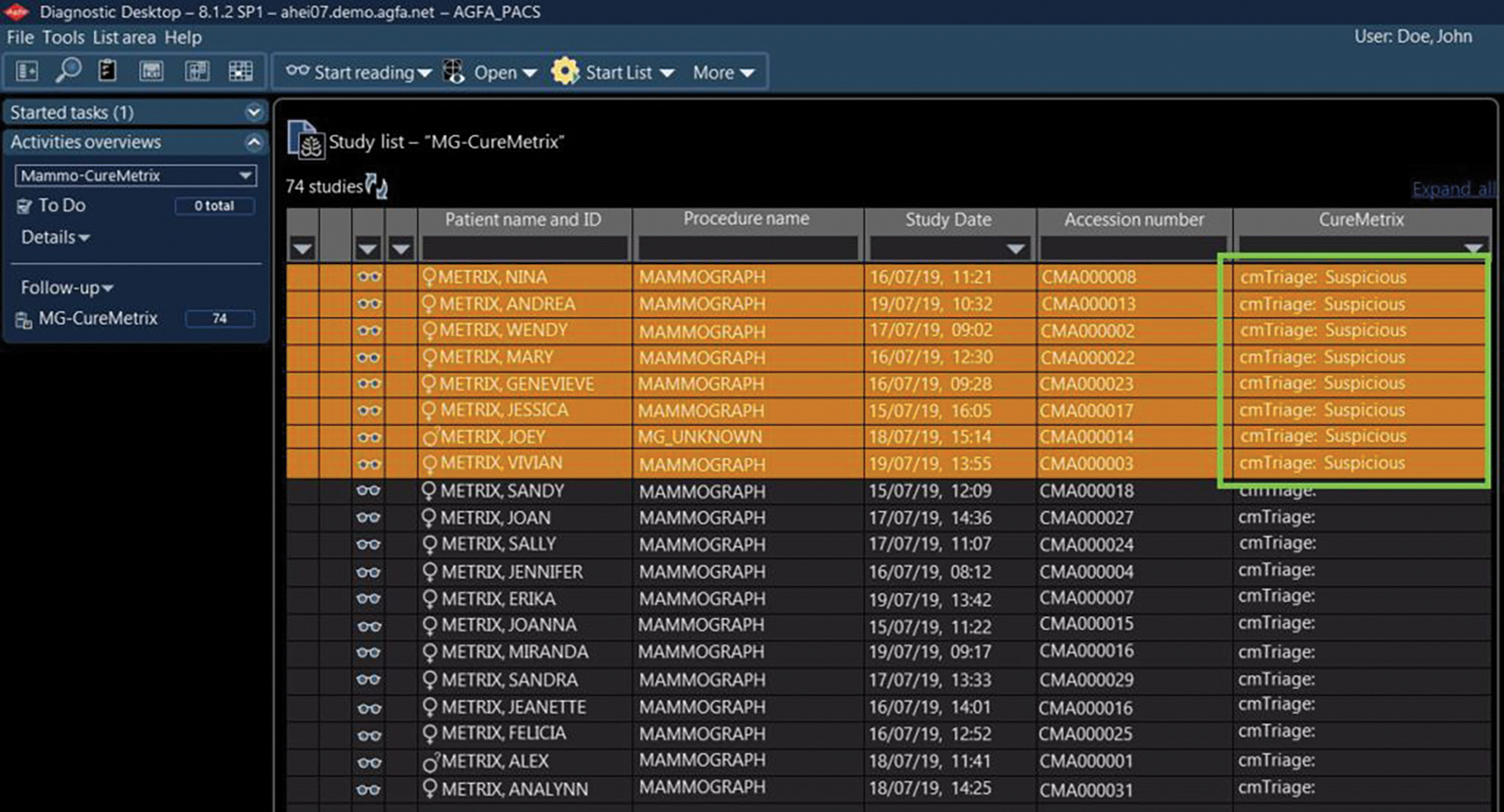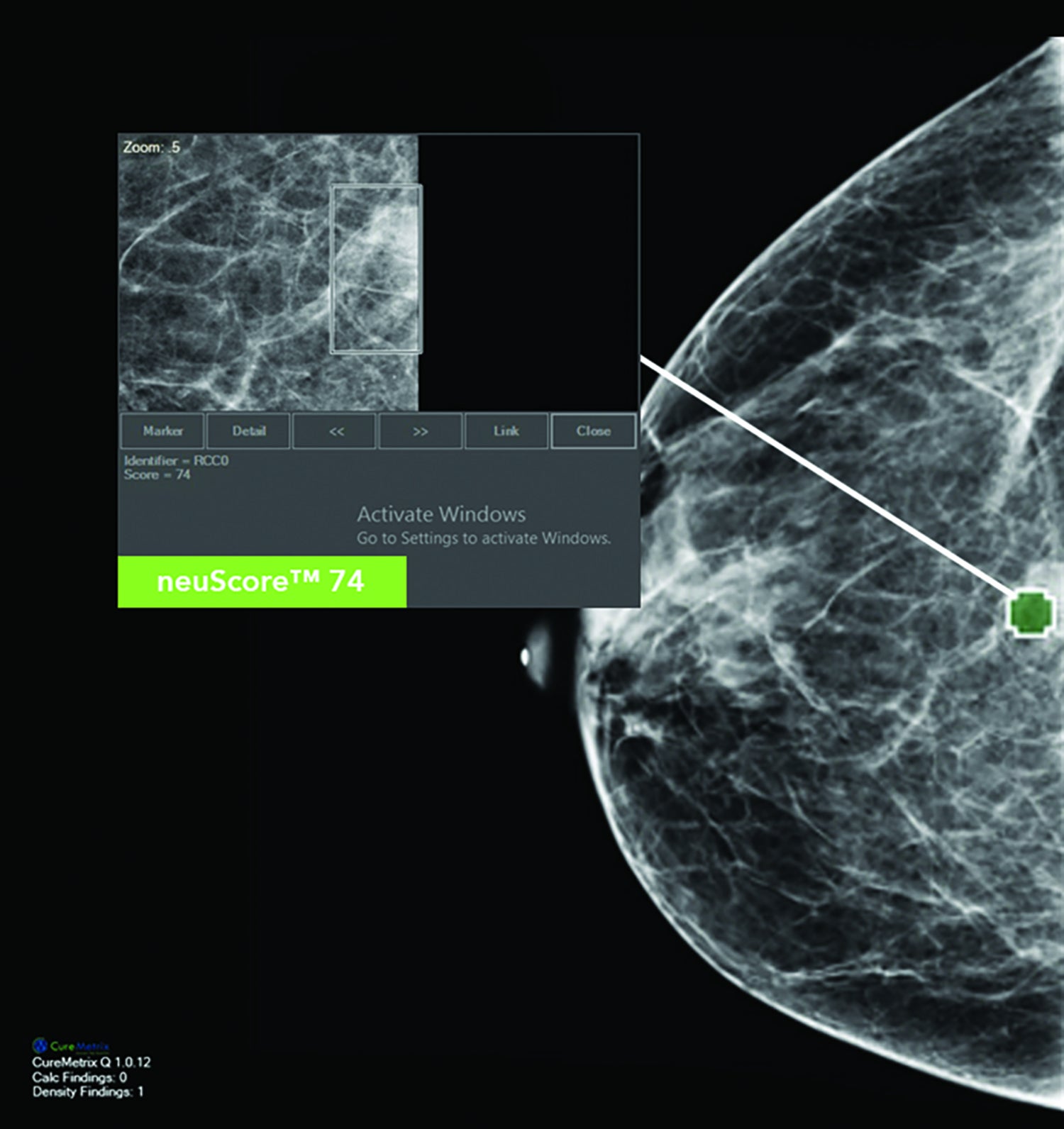The Power of Triage (CADt) in Breast Imaging
Images


Artificial intelligence (AI) has already made—and continues to make—significant impacts on radiology.
One area of clinical practice, in particular, is in triage, also known as CADt. Indeed, CAD triage already is playing an active role in some clinical practices, where a deep learning-based algorithm acts as the “first reader” of medical images and highlights cases based on suspicion level of pathology, thus providing a prioritized worklist to the radiologist as the “second reader.”
Longstanding research on error-reduction practices in aviation and surgery underscores the usefulness of prioritization to minimize human error and improve efficiencies. One study found that prioritizing urgent exams in a worklist helped improve reporting turnaround times.1 Radiologists typically read exams either in a random fashion or on a sequential “first in, first out” basis. This means suspicious cases may not be interpreted promptly, depending on practice backlogs. This inefficiency can impact practices, outcomes, and patient care.
Triage software for worklist prioritization or physician notification has been successfully deployed for medical imaging studies such as stroke imaging and other emergency indications. FDA-cleared software for stroke triage includes solutions from Avicenna, RapidAI, and Viz.ai. The benefits of these programs include direct notification of stroke teams to expedite decision making and treatment. Vendors like Aidoc also offer software that prioritizes such critical cases as intracranial hemorrhage, pneumothorax, cervical spine fracture, and pulmonary embolus.
CAD triage also holds significant benefits for mammography, where it has been shown to outperform traditional CAD. As stated in an editorial recently appearing in Radiology, “Ultimately, this innovative application [CADt] of artificial intelligence may prove more effective and reliable than conventional computer aided detection in advancing a so-called lean approach to mammographic screening.”2
CureMetrix brought the first FDA-cleared AI-based triage product for mammography to market. The company’s cmTriage automatically moves suspicious studies to the top of a worklist and expedites recall of suspicious mammogram cases. Triage can also be used to strategically distribute mammograms to multiple readers in a large practice. In addition, triage sensitivity can be set high to facilitate segregation of most-likely normal mammograms for reading.
The positive reader bias from triage can result in up to 30% faster reading times. A study presented at the Society of Breast Imaging’s 2020 annual meeting showed that an academic practice could realize up to a 55% reduction in false-positive recalls, a 12% reduction in benign biopsies, and a 17% improvement in cancer detection rates using triage workflow as compared to clinical workflows without triage.3
Case-based triage software works hand in hand with lesion-based CAD. Once a suspicious case is opened for viewing, lesion-based CAD flags areas of concern. Traditional CAD (CADe) was intended to be used as a second reader. While initial publications suggested improved reader accuracy with CADe, subsequent research in a large, multi-reader study showed an overall decrease in radiologist performance in the clinical setting, dampening enthusiasm for CADe.4 AI-based quantitative CAD, based on deep learning, is also known as CADx. CADx tools such as CureMetrix’s cmAssist can enhance sensitivity and specificity.
A recently published MD Anderson Cancer Center study demonstrated a 69% reduction in false-positive markings per image with cmAssist AI-based CAD.5 Multiple-reader studies have shown that AI-based CAD improves cancer detection rates in mammography. In one published study, cancer detection rates averaged a 27% improvement for readers of varying experience and training levels using AI-based CAD, without an increase in recall rates.5
Hologic and iCAD offer AI-based solutions designed to increase reader efficiency for 3D mammography, or digital breast tomosynthesis (DBT). Hologic’s 3DQuorum technology reconstructs 3D imaging data from the company’s DBT solution into 6mm slices that identify clinically relevant features and regions of interest. According to Hologic, 3DQuorum can reduce tomosynthesis image volume by up to 66%, or an average of 1 hour per 8 hours of image interpretation without compromising image quality, sensitivity, or reader accuracy.6
iCAD’s Profound AI analyzes DBT images to provide information on the Certainty of Finding lesion and Case Scores to assist reader efficiency. A recent study reported the solution reduced radiologist reading times by 52.7%, reduced unnecessary patient recall rates by 7.2%, and improved radiologist sensitivity by 8%.7 ICAD also reports its solution reduces reading times by up to 57.4% in women with dense breasts.8
In summary, applications of AI, particularly in triage, have become a clinical reality and are well suited to mammography, offering numerous benefits that include cost savings9 and increased efficiency, accuracy, overall practice value, and job satisfaction. It behooves all breast imagers to investigate and consider implementing AI solutions in clinical practice.
References
- Ekram T, Halabi S, Ciarelli J. Prioritizing work list to improving reporting turn-around times.. Conference: Radiological Society of North America 2011 Scientific Assembly and Annual Meeting. December 2011.
- Kontos D, Conant EF. Reviews and commentary editorial: Can AI help make screening mammography “Lean”? Radiology. 2019; 293: 47–48. https://doi.org/10.1148/radiol.2019191542
- Watanabe AT, Lim V. Workflow reduction using artificial intelligence-based mammography triage. Society of Breast Imaging Annual Meeting 2020. https://www.youtube.com/watch?v=_OVJTtpbI4U&feature=youtu.be
- Lehman CD, et al. Diagnostic accuracy of digital screening mammography with and without computer-aided detection. JAMA Intern Med. 2015; 175(11).
- Mayo RC, Kent D, Sen LC, Kapoor M, Leung JWT, Watanabe AT. Reduction of false-positive markings on mammograms: A retrospective comparison study using an artificial intelligence-based CAD. J Digit Imaging. 2019; 32(4): 618-624.DOI: 10.1007/s10278-018-0168-6 PMID: 30963339 PMCID: PMC6646646
- Hologic announces FDA approval of 3DQuorum imaging technology, powered by Genius AI. Press release. November 12, 2019. Available at: https://investors.hologic.com/press-releases/press-release-details/2019/Hologic-Announces-FDA-Approval-of-3DQuorum-Imaging-Technology-Powered-by-Genius-AI/default.aspx.
- Conant EF, Toledano AY, Periaswamy S, et al. Improving accuracy and efficiency with concurrent use of artificial intelligence for digital breast tomosynthesis. Radiol Artif Intell. 2019;1(4): e180096. doi:10.1148/ryai.2019180096
- iCAD to showcase leading breast health solutions suite including expanded ProFound AI Platform at RSNA Annual Meeting. Press release. December 2, 2019. Available at: https://www.icadmed.com/newsroom.html#!/posts/iCAD-to-Showcase-Leading-Breast-Health-Solutions-Suite-Including-Expanded-ProFound-AI-Platform-at-RSNA-Annual-Meeting/187.
- Watanabe AT, Lim V, Vu HX, et al. Improved cancer detection using artificial intelligence: A retrospective evaluation of missed cancers on mammography. J Digit Imaging. 2019; 32: 625. https://doi.org/10.1007/s10278-019-00192-5
Citation
W W. The Power of Triage (CADt) in Breast Imaging. Appl Radiol. 2020;(5):36-37.
September 1, 2020